High-performance agile teams are always striving for an effective retrospective that enables the team to discuss success criteria and define the areas of improvement further. This practice is especially helpful in DevOps, where there is a constant need for cross-functional teams—development, operations, database administrators, systems administrators, QA testers, and product managers—to focus on excellent communication and collaboration. Collaboration is the key ingredient for a successful DevOps implementation. One of the remarkable characteristics of DevOps is that it encourages feedback loops and experimentation so that teams ascertain the best practices and continuously improve their process.
Over the years, my experience has been that retrospectives can get monotonous, and that’s when they tend to become ineffective. The more I performed retrospectives, the more I felt the need to revolutionize the process and bring out something new, fun, and exciting to make the retrospectives vibrant.
During my research into the subject, I came across the idea of gamification and discovered the universality of its application. Using gaming elements in your retrospectives brings a completely different dimension of thinking—and makes the process fun! Read on for some ideas from the site Innovation Games that will revitalize your typical boring retrospectives.
Garden Your Thoughts
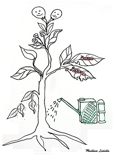
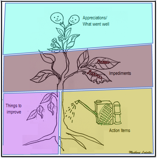
As I was watering the plants in my garden one lazy Sunday morning, I found a few insects perched on some leaves. Initially, I ignored them, thinking they would disappear on their own. However, within a week, I saw that the whole plant was eaten up and it was almost about to perish.
This should definitely remind us of few scenarios we’ve encountered in our daily work. Often, we see impediments coming our way, but we ignore them because we believe they don’t demand our urgency. However, these things eventually pose a major risk for the entire project. What could have been avoided will become an impossible problem. This situation is particularly relevant to agile teams. Because collaboration is crucial for the health of agile lifecycles, any small issue left unattended ends up slowing down the entire value chain.
The next time I was conducting a retrospective with teams, I drew a picture of a plant on the board. “Look,” I said, “this plant is our project, and I would like us to do the following things.”
Think of all the bottlenecks that, if not addressed, would eat us up like a hungry worm devours leaves. Identify best practices that really worked well for us, and continue to work on them, just as we would care for flowers. Realize collectively what it is that we want to try differently so that we stay on the right track, just like how we would nourish the plant with fertilizer and pesticides, the necessary action items. Lastly, identify potential areas of improvement, as we would tend to the drooping leaves on a plant.
Snakes and Ladders
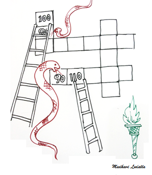
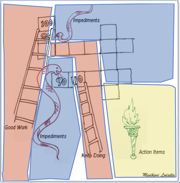
Snakes and Ladders is an ancient Indian board game regarded as a classic worldwide. This game usually involves two or more players, and they take turns to move up a grid by rolling a die. On the way to the finish, the players meet with hurdles in the form of snakes and opportunities in the form of ladders. Whenever a player encounters a snake, he is thrown back to an earlier position, impeding his success. Whenever a player encounters a ladder, he gains an opportunity to skip blocks and climb to a higher position.
As I watched my two little girls play this game with their friends at home, I could correlate the experience to agile teams as they go through iterations to meet set goals. However, unlike in the game, it is not enough if one person wins. When it comes to an agile project, the game would be really successful only when all the team members and functions climb the ladders and reach the iteration goal. There will be unfortunate setbacks on a team’s journey, just as in the game, but it is important that we face them together.
During another of our team retrospectives, I said, “Imagine we are all playing a game of Snakes and Ladders. How do we propose that all of us reach the top block at the same time?” Imagine the snakes to be the impediments teams face during their iterations. Think of the ladders as the best practices we should continue following and would help us realize our iteration goal.
Simple as this approach might be, the clear message here is that applying basic concepts of gamification in retrospectives does two things: makes the process more fun and exciting, and brings out ideas that would not have been thought of through conventional approaches.
Put the Ball in the Basket
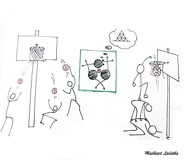
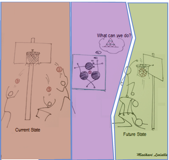
Basketball is one of my favorite sports, and I used to play with friends at school quite often. I was taking a trip down nostalgia lane when I remembered how our team once made it to the finals in an interschool competition. But we had a big fight the day before when our coach selected another person to be the captain. There was a war of words that followed, and everyone began to lose confidence in the team. I remember going to bed with a sense of fear and guilt.
After many years, I had the discomfort of recalling this memory during a retrospective as I saw that individual team members were trying hard to put the ball in the basket on their own, without keeping the entire team in mind. That mentality does not prove useful in the long run because team members lose focus of the big picture and move farther and farther away from it. However, the same memory from school provided a solution to the problem.
The day of the basketball finals, my team stepped onto the court not knowing what to anticipate. Once the game started, it was refreshingly positive to see that in spite of the bitterness from last night, the team coordinated perfectly—and we went on to win!
When I remembered this during the retrospective, the answer hit me like a ton of bricks. Achieving success is not going to be easy. We have to learn to respect our differences and work closely as a team when there is a larger goal in sight. Agile and DevOps teams especially need to remember this, because cross-functional teams must collaborate well.
I went on to apply this valuable lesson into one of the team exercises. The team was given a task of brainstorming bottlenecks to a shared goal. Each of the members had to debate and oppose each other’s ideas to reach a common goal at the end. Bringing different perspectives to the foreground worked well.
During the retrospective, I drew the picture above and told the team that the first scenario depicted is the individual team members trying to focus on their own goals, which will prevent them from meeting the team goal. You have to think of the shared team goal and think of things to do so that the team can move from the situation on the left to the collaboration on the right. Asking the team to think of what they can do to win the game caught everyone’s attention and made the retrospective very lively and engaging.
Find What Works for You
The methods mentioned here may not work for everyone or in every situation; much depends on the team composition and on the environment. But agile and DevOps teams can benefit greatly from effective retrospectives, so it’s important to find a method of making them valuable that works for your specific situation.
Teams need to regularly engage in outside-the-box thinking and appreciate the opportunities for improvement that retrospectives bring. I encourage you to draw from your own experiences and pass your reflections on to your team.
These games are available online at Innovation Games. If you'd like the links to the games mentioned in this article so you can explore gamification, please contact the author at [email protected].

